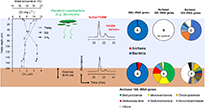** Progress in Earth and Planetary Science is the official journal of the Japan Geoscience Union, published in collaboration with its 50 society members.
Gallery View of PEPS Articles
Paper with full data attached
Biogeosciences
202111202111
Detection of planktonic coenzyme factor 430 in a freshwater lake: Small-scale analysis for probing archaeal methanogenesis
Urai A, Matsushita M, Park HD, Imachi H, Ogawara M, Iwata H, Kaneko M, Ogawa NO, Ohkouchi N, Takano YUrai A, Matsushita M, Park H, Imachi H, Ogawara M, Iwata H, Kaneko M, Ogawa NO, Ohkouchi N, Takano Y
Planktonic methanogen, Coenzyme F430, mcrA, Lake Suwa, Surface hydrosphere
Structural formula and 3D spectrum of coenzyme factor 430.
Cross-section of UUS rRNA gene sequencing and coenzyme F430 analyses of the planktonic cyanobacterial bloom sample and benthic sediment.
We present the first data describing molecular evidence of planktonic coenzyme factor 430 (hereafter referred to as F430), a key signature of methanogenic archaea, obtained from a water column sample in a freshwater lake in Japan. We report concentrations of native F430 ranging from 6.8–35 × 102 femto mol g-wet−1 and 8.5–86 × 102 femto mol g-wet−1 in the water column and core-top sediment, respectively. Among these profiles, the epimer F430 of the deactivated chemical formula was very low overall in both planktonic and benthic environments. Small subunit (SSU) rRNA gene sequencing revealed that the planktonic microbial community was clearly different from that of the benthic sediment. Planktonic cyanobacteria (e.g., Microcystis) were predominant in the water column, whereas a wide variety of bacteria and archaea, including methanogens (e.g., Methanobacterium, Methanoregula, Methanothrix, Methanosarcina, and Methanocella), were observed in the core-top sediment. These results suggest that the planktonic cyanobacterial community may be rapidly degraded at the water–sediment interface driven by activated benthic microbial heterotrophic processes.







